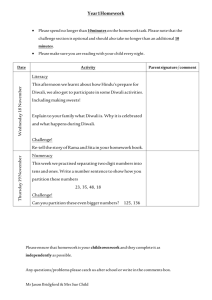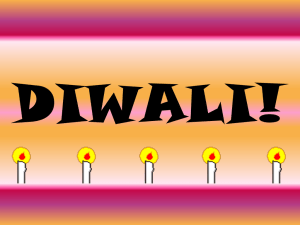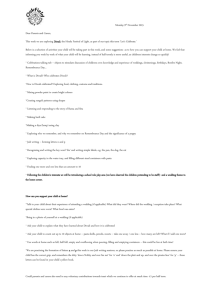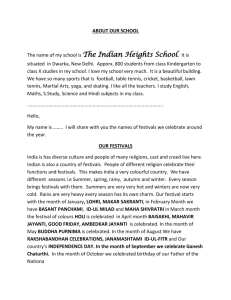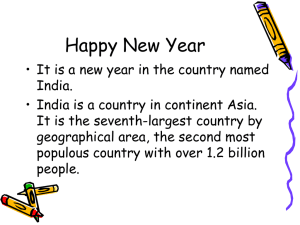Diwali - India
advertisement
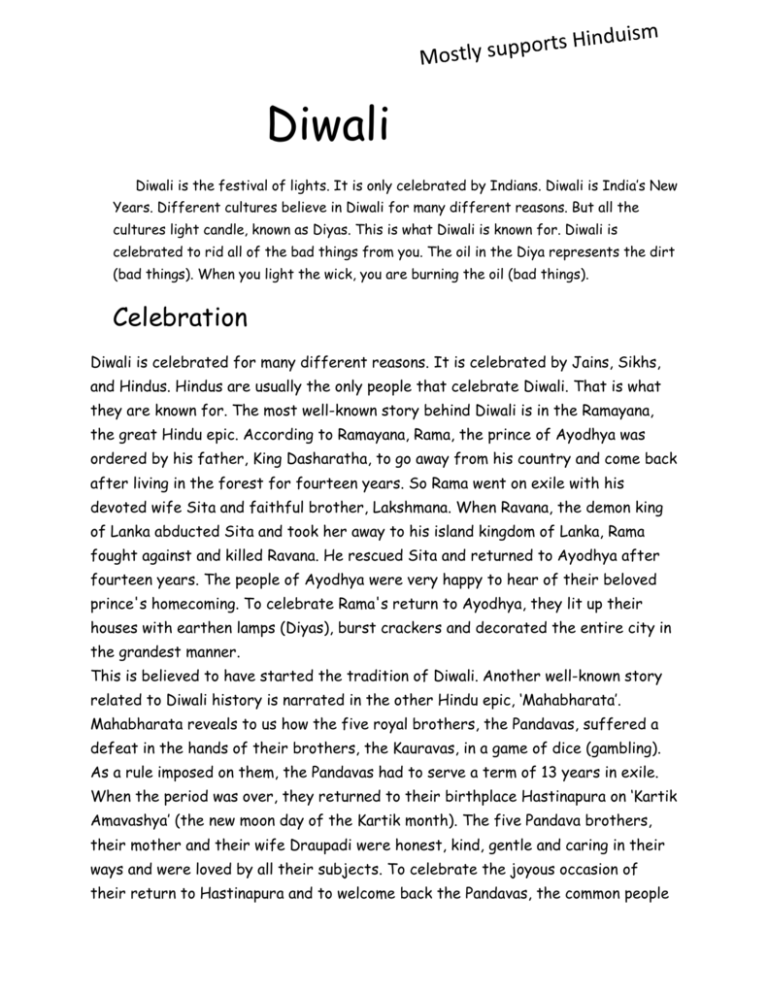
Diwali Diwali is the festival of lights. It is only celebrated by Indians. Diwali is India’s New Years. Different cultures believe in Diwali for many different reasons. But all the cultures light candle, known as Diyas. This is what Diwali is known for. Diwali is celebrated to rid all of the bad things from you. The oil in the Diya represents the dirt (bad things). When you light the wick, you are burning the oil (bad things). Celebration Diwali is celebrated for many different reasons. It is celebrated by Jains, Sikhs, and Hindus. Hindus are usually the only people that celebrate Diwali. That is what they are known for. The most well-known story behind Diwali is in the Ramayana, the great Hindu epic. According to Ramayana, Rama, the prince of Ayodhya was ordered by his father, King Dasharatha, to go away from his country and come back after living in the forest for fourteen years. So Rama went on exile with his devoted wife Sita and faithful brother, Lakshmana. When Ravana, the demon king of Lanka abducted Sita and took her away to his island kingdom of Lanka, Rama fought against and killed Ravana. He rescued Sita and returned to Ayodhya after fourteen years. The people of Ayodhya were very happy to hear of their beloved prince's homecoming. To celebrate Rama's return to Ayodhya, they lit up their houses with earthen lamps (Diyas), burst crackers and decorated the entire city in the grandest manner. This is believed to have started the tradition of Diwali. Another well-known story related to Diwali history is narrated in the other Hindu epic, ‘Mahabharata’. Mahabharata reveals to us how the five royal brothers, the Pandavas, suffered a defeat in the hands of their brothers, the Kauravas, in a game of dice (gambling). As a rule imposed on them, the Pandavas had to serve a term of 13 years in exile. When the period was over, they returned to their birthplace Hastinapura on ‘Kartik Amavashya’ (the new moon day of the Kartik month). The five Pandava brothers, their mother and their wife Draupadi were honest, kind, gentle and caring in their ways and were loved by all their subjects. To celebrate the joyous occasion of their return to Hastinapura and to welcome back the Pandavas, the common people illuminated their state by lighting bright earthen lamps everywhere. The tradition is believed to have been kept alive through the festival of Diwali, which many believe, is held in remembrance of the Pandava brothers' homecoming. Diya Diya is an oil lamp, usually made from clay, with a cotton wick dipped in ghee or vegetable oils. Diyas are used for many reasons. The general reason is to rid the bad. It is to bring out the good. Another reason Diyas are used is: to lead Rama into your house. The five days of Diwali . The first day of Diwali: Dhanteras The first day of Diwali is called Dhanvantari Triodasi or Dhanwantari Triodasi also called Dhan Theras. It is the thirteenth lunar day of Krishna Paksh. On this day, Lord Dhanwantari came out of the ocean with Ayurvedic for mankind. This day marks the beginning of Deepawali celebrations. On this day at sunset, Hindus should bathe and offer a lighted Diya with Prasad (sweets offered at worship time) to Yama Raj, the Lord of Death and pray for protection from untimely death. This offering should be made near a Tulsi tree, the Holy Basil or any other sacred tree that one might have in their yard. The second day of Diwali: Choti Diwali The second day of dipawali is called Narak Chaturdasi. On this day Lord Krishna destroyed the demon Narakasur and made the world free from fear. On this day, one should massage the body with oil to relieve it of tiredness, bathe and rest so that Diwali can be celebarated with vigour and devotion. On this night, Diya should not be lit. The Shastras (Laws of Dharma) declares that Diya should be offered on Triodasi night with Prasad. Some people mistook it to mean that because Yama Diya was lit on that night, that it should always be lit on the night before Diwali. This is absolutely not true. It is advisable that one consults with a learned Pandit or Hindu Astrologer for proper guidance on this matter. The third day of Diwali: Lakshmi Puja on Diwali This is the day when worship unto Mother Lakshmi is performed. Hindus cleanse themselves and join with their families and their Pandit (priest) and they worship the divine Goddess Lakshmi to achieve the blessings of wealth and prosperity, the triumph of good over evil and light over darkness. The fourth day of Diwali: Padwa & Govardhan Puja On this day, Govardhan Pooja is performed. Many thousands of years ago, Lord Krishna caused the people of Vraja to perform Govardhan Pooja. From then on, every year Hindus worship Govardhan to honour that first Pooja done by the people of Vraja. The fifth day of Diwali: Bhai Duj The fifth day of the Diwali is called Bhai teeka. This is the day after Goverdhan Pooja is performed and normally two days after Diwali day. It is a day dedicated to sisters. Many moons ago, in the Vedic era, Yama (Yamraj, the Lord of death) visited his sister Yamuna on this day. He gave his sister a Vardhan (a boon) that whosoever visits her on this day shall be liberated from all sins. They will achieve Moksha or final emancipation. From then on, brothers visit their sisters on this day to enquire of their welfare. This day marks the end of the five days of deepavali celebrations. This is also known as Bhai fota among Bengalis. Bhai fota is an event especially among Bengalis when the sister prays for her brother's safety, success and wellbeing. Rangoli Rangoli is a traditional Indian art. It is made by colorful rice flour. It is used to welcome guest into someone’s house. Also, it is used to celebrate Diwali. Diwali is a very colorful holiday and a festivity. Rangoli makes it this way. The most common way of making a Rangoli is to pinch the thumb and let the forefinger and let the color run freely out of the gap. Rangolis are vivid and simple two-dimensional pieces of art. Let’s conclude Diwali is A festival that gets rid of the bad Is very colorful Celebrates the return of Rama from Ayodhya Includes Diyas Rangoli Sweets Fireworks

